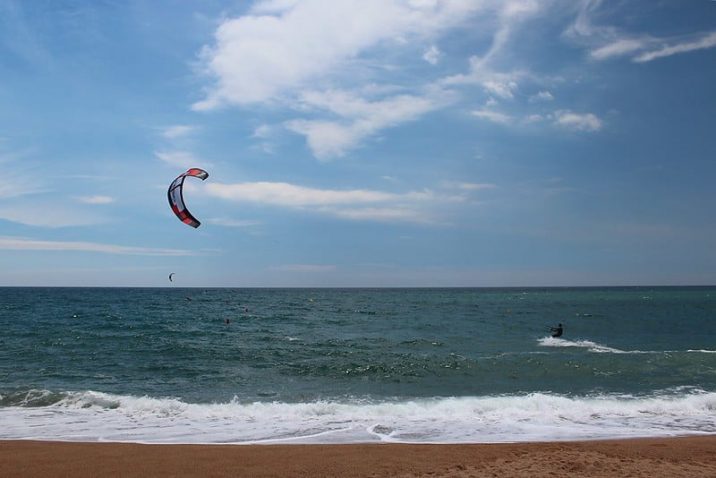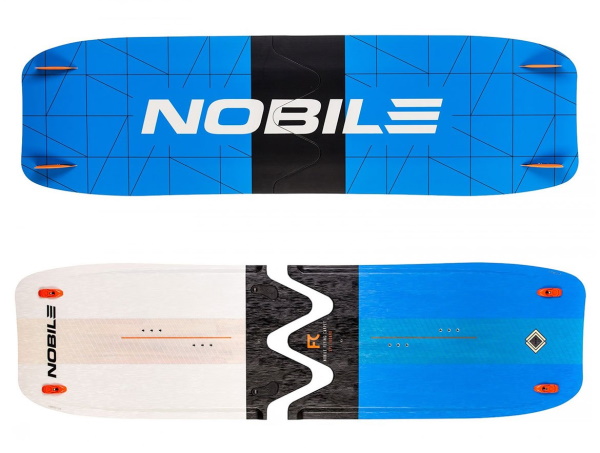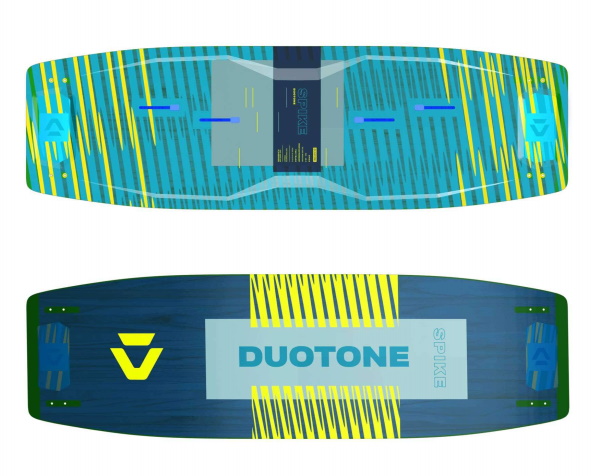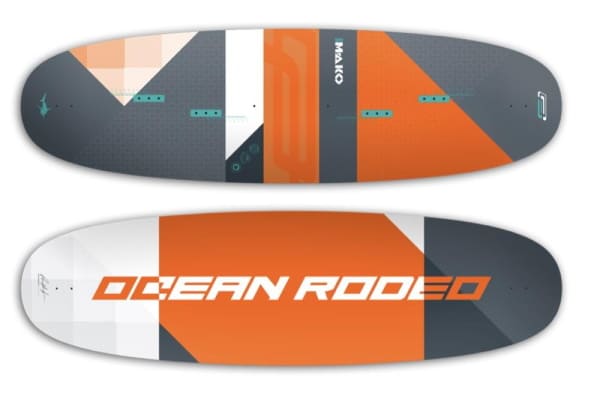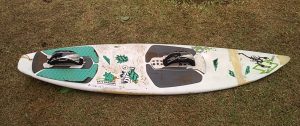Choosing a kiteboard is always a challenge. This is particular true for a beginner kiter as your kite control skills are still relatively low. Newer riders often struggle in low wind for maintaining speed and staying upwind without losing ground.
Even for non-beginners, kiteboarding in light wind can be greatly facilitated by choosing a the right lightwind kiteboard. These boards often make good beginner kiteboards as well.
Here are my top 4 kiteboards for light wind and/or for a beginner rider:
| KITEBOARD | BEST FOR | PRICE | |
|---|---|---|---|
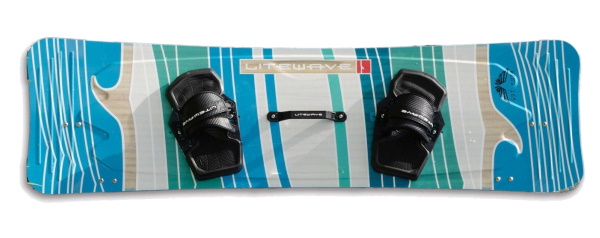 | 1. Litewave Wing | Ultimate lightwind session saver, very easy to learn on, affordable | $600 |
 | 2. Nobile Flying Carpet | Best lightwind kiteboard for travel. Stiffer, upwind performance | $950 |
 | 3. Duotone Spike | Best for lightwind freeride, suitable for intermediate beginners | $730 |
 | Ocean Rodeo Mako | Best for lightwind carving, choppy water, beginners in waves | $899 |
Before we dig into each of the above boards, let’s briefly discuss what makes a good lightwind or beginner board.
Table of Contents
What makes a good beginner or light wind kiteboard?
For both newer riders and light wind, a bigger kiteboard is generally recommended. While length is important, width, rocker, and outline are even more essential for a beginner/light wind kiteboard. You’ll generally want a board with a big and wide boxy outline.
Kiteboard size
Rider weight plays a key role in determining how large a board you should choose as a beginner or for light wind. The heavier you are, the more edge surface area you want immerged in the water for earlier planing and better upwind edging.
The following table provides a helpful indication of what size board to choose based o rider weight for a beginner rider or for light wind conditions:
| Weight (Lbs) | Weight (kg) | 1 board quiver | 2 board quiver |
|---|---|---|---|
| 100 | 45 | 128-133 | 126-130, 135-143 |
| 120 | 55 | 130-135 | 128-133, 137-145 |
| 140 | 64 | 132-137 | 130-135, 139-147 |
| 160 | 73 | 134-139 | 132-137, 141-150 |
| 180 | 82 | 137-142 | 134-139, 145-160 |
| 200 | 91 | 140-150 | 137-142, 150-165 |
| 220 | 100 | 145-155 | 140-145, 160-165 |
In contrast, rider height is not as important for determining kiteboard size.
While the above table is a useful rule of thumb, your mileage will vary based on your riding level and kite type. For example, an experienced 65 kg rider with a 14.5m Ocean Rodeo Flite and a 146 x 46 door-style twintip will stay upwind from 9 knots, do kite loop tricks from 12 knots, and boost big airs from 15 knots.
Rocker
You also want your light wind board to be on the flat side with as little rocker (lengthwise curvature) as possible. The less rocker a kiteboard has, the early it starts planing above the water, and the easier it is to stay upwind.
On the flip side, more rocker will generally give you a smoother ride in choppy water.
Price point
Every brand has an entry level price point board for beginners and/or light wind. These boards generally work well for these situations. Examples include Cabrinha Spectrum, Duotone Gonzalez, Crazy Fly All around, etc.
Quiver size
If you want to cover a full range of wind, it’s generally a good idea to have 2 boards, one for light wind, and one for medium-to-high winds. As a beginner you can learn with the lightwind board and acquire the other one as you progress.
The good news is, your beginner board will continue to serve as a great light wind board.
If you only want one board, you’ll probably be better off choosing a price point board at the beginning, something cheap and on a bigger side (though not too huge). Once you get comfortable staying upwind without being overpowered and changing direction, you’ll likely want to switch to a smaller, better performing board.
Skills & kite size
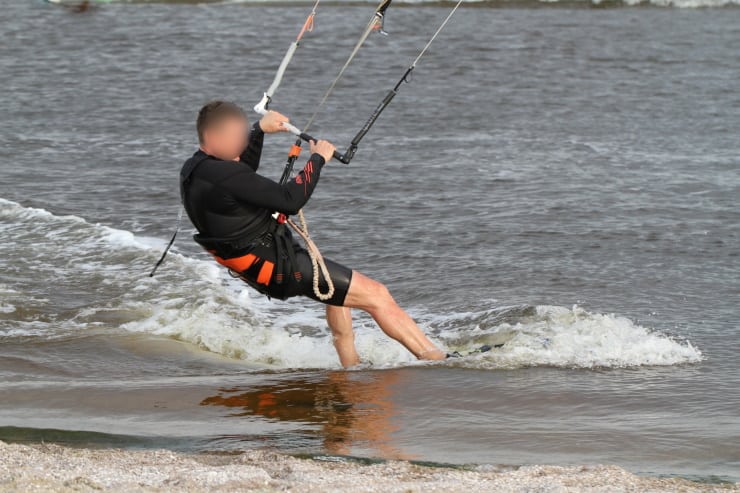
In light wind, your board’s size and shape and your skill level will matter even more than kite size. An 85 kg rider in 15 knot wind with a 17m kite will typically need to work hard to ride upwind. With good technique, however, a 12m kite paired with a large lightwind kiteboard might give better results.
The type of kite also impact affects your choice of kiteboard for light wind and/or for learning. Some kites are more powerful with better low-end, and will perform better in light wind even with a relatively smaller board.
Foil board
Below 13 knots, a foil board is typically the best option. Experienced foilers are often able to go out in 12-13 knots with a kite as small as 5m and long lines, while twintip riders on 18m kites are struggling.
Investing in a hydrofoil can be a good alternative to getting a bigger kite, getting a very big board (door-style), or extending your lines by 10 or 15 meters. A foil board – e.g. one of these – will allow you to significantly extend the low-end wind range of your existing kite and let you cruise in as low as 8 knots, or even do big airs in 15 knots.
Seasoned foilers are even able to do some freestyle in as little as 10-12 knots with a 14-15m foil kite and a big and wide board – e.g. 140 x 42 for a lighter rider.
The main cons of the foil option is that it’s a lot more technical than the twintip, so a beginner may have a hard time getting started. Also, to foil in super low winds, you’ll typically need a special lightwind kite, as regular kites will likely drop and fail to relaunch.
Strapless surfboard
Another option for light wind is a strapless board – e.g. one of these. These can let you ride a few knots earlier. Surfboard and strapless riding, however, require additional skills compared to twin tip riding, so this option may not be initially accessible for a beginner rider.
Nugget type boards, like the much celebrated Ocean Rodeo Mako lightwind and beginner board (see later section), have even more volume than regular kite surfboards, and thus can add even more low-end to a given kite. Nugget boards are easier to learn on, but riding them strapless is still a challenge for newbies.
Lightwind riders (average weight) will often pair a 14-15m kite with a directional surfboard, allowing them to go out and have fun starting from 9-10 knots.
#1: Litewave Wing: ultimate light wind session saver
The Wing is a huge 165cm x 46cm lightwind board – though it also comes in 155cm x 44. It gets its name from its shape featuring a narrowed hip (41cm) and flared out tips (like a wing), unlike “normal” kiteboards which typically taper in.
This wing-style design gives the board a lot of extra planing surface on the corners. The back corner is where most of your weight goes when edging and pressing down on your back foot. The Wing’s tried and tested design has been around for a long time.
The sidecut outline (narrow waist) combine with the wide tips to greatly improve planing and upwind capability in light wind – it rides upwind like a machine. Some riders say it’s like adding 4m to your kite. The flared tips prevents face spray.
Another distinguishing aspect of the Litewave Wing is that it has a lot more rocker than most other big lightwind boards, which are mostly flat. Here again, the unique design makes it possible to have rocker without affecting the board’s light wind abilities.
The advantage of a strong rocker is that the board feels closer to a regular small kiteboard despite its size, unlike most big door-style boards. The Wing has just enough rocker for chop and even waves. The rocker also makes the Wing a lot easier to jump and freestyle with as it doesn’t have the tension of a typically lightwind board.
The Wing has a stiffener that runs along its length except for the last 4 inches on each end. The wide tips also have stiffeners running widthwise, enabling the Wing to flex and pop without the whole board folding. Riders love that the Wing can be loaded hard for energetic launching even in light winds.
The Wing is optimized for carving. The tips are made very thin and flexy for carving performance. This board also has the biggest concave of any lightwind board for a smooth carving ride.
In light wind, you tend to ride with the board flatter on the water than in stronger winds. For this reason, the Litewave Wing is has all the fins placed on the heel side of the board as opposed to on both sides. This gives the board extra traction when riding upwind.
Riders often praised the Wing for being lightweight and durable, and many like the see-through graphics that show the wood grain. At $599 it’s also a relatively affordable board.
Check out the Litewave Wing on Green Hat ($600)
#2: Nobile Flying Carpet split board: best travel board for light wind
The Flying Carpet is a well-rated 160cm x 46cm lightwind and beginner-friendly twitip that has been around for many years. It’s the only lightwind board specifically geared to traveling.
The split feature makes it easy to instantly fold the board into a very compact, luggage-friendly sac. Check out this video for how to put it together:
The Flying Carpet is wide and very stable, with a large surface for easy planing. Besides the split feature, another thing that sets it apart is it’s asymmetrical shape with a long backside edge for grip and upwind performance and a curved edge for better carving.
The curved/cutout edge helps support the weaker toe side when riding and reduces foot pressure when edging – an issue many lightwind boards suffer from as edging hard often results in shin fatigue due to the wide profile and strap placement. The curved radius helps reduce fatigue and adds comfort when carving.
The FC is stiffer than other lightwind boards and much more torsion resistant due to the pre-stressing process it goes through. The stiffness results in significant pop on this board. Pre-stressing also makes this board thinner, lighter, and more resistant.
The Flying Carpet features a hybrid concave (with channels in the tips) for improved smoothness and speed.
Owners of this board describe it as a great light wind board, particularly in 8-13 knots. It’s found to be very helpful in gusty conditions as it keeps churning through lulls even when underpowered. For this reason, it’s also a good option for beginner kiters.
Riders find the FC is particularly efficient for riding upwind. Some find it quite demanding on the legs despite the curved edge feature, e.g. when edging hard overpowered for loading.
Check out the Nobile Flying Carpet light wind kiteboard on Green Hat
#3: Duotone Spike: best for lightwind performance
The Duotone Spike is a 153cm x 46.5cm lightwind twintip kiteboard. Although it doesn’t follow the huge door approach of other lightwind boards, the Spike excels in lightwind freeride performance.
Contrary to the Litewave, the Spike has a somewhat rounded outline slightly tapered at the ends – although the tips remain quite wide for early planing. The size and shape of this board also make it a very valid option for an intermediate learner who doesn’t want the bulk of a door board.
While it doesn’t have the wing shape of the Litewave, the Spike is quite narrow which gives it more speed and upwind abilities.
Despite its reasonable size, the Spike has an maximized surface area that allows it to get planing with minimum pull from the kite. Unlike the Litewave Wing, this board has a flat rocker which also contributes to early planing and gives it good speed even with minimal power.
What sets this board apart is it’s innovative flex tip and rocker construction. When the wind is low, the board stays flat for fast planing, but when kite powers up, the rocker line scoops up more for better control and stability.
The soft tips give the board good control at speed and improve carving. Meanwhile, the stiff outside frame and medium-plus flex result in great pop, allowing you to do jumps and freestyle tricks even with little wind and kite power.
Similar to the Litewave Wing, the Spike has a torsion bar along its length giving it more grip on the heel side for better upwind capability. The Spike’s outline is straight in the middle, which also adds to the pop and sharp edge grip.
Check out the Duotone Spike lightwind board on Green Hat ($730)
Note: the Spike also comes in a high-end SLS carbon version. Much pricier at $1100, the SLS is a lot lighter, super durable, and more responsive and high-performance than the regular layup.
#4: Ocean Rodeo Mako
The Ocean Rodeo Mako is very different from the standard twintips and even door-style boards we’ve seen so far. This board, which has been around for 17 years, is marketed as a surf-orientated and carving twintip. The Mako comes in 4 sizes:
- 135 x 37 cm
- 140 x 40 cm
- 150 x 40 cm
- 165 x 44 cm
The Mako has a very unique rounded outline with all rounded tips that give it a very different riding feel. Also, unlike standard twintips, it has only 2 fins, one at each end, placed on the board’s centerline. The board is very stiff (unlike “normal” twintips) and has a very large concave.
So how does it fare for a beginner and light wind performance? The Mako offers a large surface area allowing it to plane easily and deliver a very smooth and comfortable ride when ridden with moderate power. The 150 and 165cm versions are particularly well-suited for newer riders and/or light wind.
Compared to regular lightwind boards, The Mako particularly excels in smooth rail-to-rail carving in choppy water and small waves thanks to its shape, concave, and fin setup.
This kiteboard is not the best twintip option for learning freestyle tricks due to its stiff construction – wake-style pop requires flex. However, it provides the smoothest and most pleasant carving experience in chop and messy water, even in lighter winds.
As a beginner, the Mako facilitates learning as it allows you to ride in a more comfortable position, closer to a surfboard stance, as opposed to a regular twintip where you need to lean back a lot more when edging upwind.
One last thing: the mako is virtually undestructible, it’s very sturdy and built to last – even if you end up on the rocks because the wind dropped and you don’t have the necessary skills to ride back up.
Check out the Ocean Rodeo Mako on Green Hat ($899)
Photo credits:
Featured image: “Kitesurf” (CC BY-SA 2.0) by Albert T M


